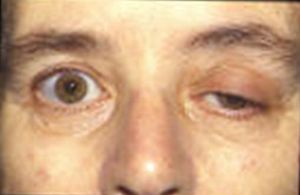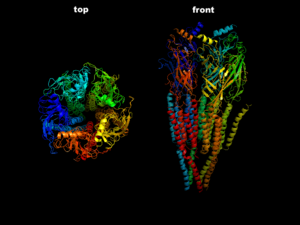وهن عضلي
| الوهن العضلي Myasthenia gravis | |
|---|---|
 | |
| Detailed view of a neuromuscular junction: 1. Presynaptic terminal 2. Sarcolemma 3. Synaptic vesicle 4. Nicotinic acetylcholine receptor 5. Mitochondrion | |
| التبويب والمصادر الخارجية | |
| ICD-10 | G70.0 |
| ICD-9-CM | 358.0 |
| OMIM | 254200 |
| DiseasesDB | 8460 |
| MedlinePlus | 000712 |
| eMedicine | neuro/232 emerg/325 (emergency), med/3260 (pregnancy), oph/263 (eye) |
| Patient UK | فشل عرض الخاصية P1461: لم يتم العثور على الخاصية P1461. وهن عضلي |
| MeSH | D009157 |
الوهن العضلي Myasthenia gravis مرض غير مُعْد يتميز بضعف العضلات الهيكلية. ويزداد هذا الوهن مع النشاط الجسماني ولكن يُمكن تسكينه جزئيا بأخذ قسط من الراحة. ويُمكن أن يُصاب بالمرض الرجال والنساء من مختلف الأعمار. ولكنه غالبًا ما يكون أكثر تكرارًا عند النساء من عمر 15 إلى 30 سنة والرجال من عمر 40 إلى 70 سنة.
يصيب الوهن العضلي العضلات الهيكلية للوجه بصفة خاصة، كما يُصيب العنق واليدين والقدمين. وقد تشمل الأعراض ارتخاء الجفنين، ووهن اليدين والقدمين، وصعوبة التنفس والمضغ. ويصعب تشخيص المرض لأن الأعراض المُبكرة غالبًا تكون طفيفة، وقد تظهر وتختفي.
ويعتقد معظم الباحثين بأن الوهن العضلي يحدث نتيجةً لقصور في نقطة اتصال عصبية عضلية، وهي النقطة التي تنتقل فيها النبضة العصبية إلى العضلة. وعادةً ما تنطلق مادةٌ تُسمى الأستيلكولين من المُنتهى العصبي وتُصبح ملتصقة بالجزيئات المستقبلة في العضلة، فتجعل العضلة تتقلص. وفي حالة الوهن العضلي يتداخل شيءٌ ما مع وصلة العصب إلى العضلة. ويظن كثيرٌ من الباحثين أن الوهن العضلي مرضٌ ذاتي المناعة. وفي مثل هذا النوع من الأمراض، يقوم جهاز مناعة الجسم، الذي يُهاجم في العادة البكتيريا والفيروسات الضارة، بمهاجمة أنسجة الجسم نفسه. ويبدو أن جهاز المناعة يقوم بتدمير الجزيئات المستقبلة في العضلات.
وبالعلاج يُمكن لمعظم ضحايا الوهن العضلي أن يعيشوا في أغلب الأحيان حياةً طبيعيةً تمامًا. ويُعالج الأطباء أعراض المرض بعقاقير تُسمى مسوخ مُضادات الكولين، وقد يكون استخدام عقاقير الكورتيزون نافعًا أيضًا.
كما أن استئصال التوتة، وهي جزء من جهاز المناعة، قد يُساعد المريض، خاصة أثناء المراحل المبكّرة من المرض. وفي حالات متقدمة معينة، يقوم الأطباء بسحب دم المريض وتطهيره من المواد المناعية التي قد تُهاجم المستقبلات العضلية. وحينئذ تتم إعادة نقل الدم النقي إلى جسم المريض وتُستخدم العقاقير الكابتة للمناعة أيضًا في معالجة المرض.
التصنيف
- Class I: Any eye muscle weakness, possible ptosis, no other evidence of muscle weakness elsewhere
- Class II: Eye muscle weakness of any severity, mild weakness of other muscles
- Class IIa: Predominantly limb or axial muscles
- Class IIb: Predominantly bulbar and/or respiratory muscles
- Class III: Eye muscle weakness of any severity, moderate weakness of other muscles
- Class IIIa: Predominantly limb or axial muscles
- Class IIIb: Predominantly bulbar and/or respiratory muscles
- Class IV: Eye muscle weakness of any severity, severe weakness of other muscles
- Class IVa: Predominantly limb or axial muscles
- Class IVb: Predominantly bulbar and/or respiratory muscles (Can also include feeding tube without intubation)
- Class V: Intubation needed to maintain airway
Signs and symptoms

Pathophysiology
Associated condition
في الحمل
Diagnosis
Physical examination
اختبارات الدم
Neurophysiology
Edrophonium test

التصوير
Pulmonary function test
Pathological findings
العلاج
العلاج
Plasmapheresis and IVIG
الجراحة
Prognosis
علم الأوبئة
مرضى مشاهير
- Amitabh Bachchan, Bollywood superstar, voted Star of Millennium on BBC.
- Gregory Chudnovsky, mathematician
- Brandon Cox, starting Auburn Quarterback from 2005-2007. Finished with a record of 29-9.
- Noah Dietrich
- Henrique Mecking, Brazilian chess grandmaster.
- Christopher Robin Milne, 1920–1996, of Winnie-the-Pooh fame and son of author A.A. Milne.
- Aristotle Onassis, Greek shipbuilder and husband of Jacqueline Kennedy Onassis.
- Augustus Pablo, reggae musician. Died May 18, 1999 due to a collapsed lung having suffered from the disease for some time.
- Suzanne Rogers, Emmy award winning daytime television actress; plays Maggie Horton on Days of our Lives. Diagnosed in 1984, but currently in remission; her condition was dramatized on the series as her character was shown to be suffering from it as well.
- Roger Smith, semi-retired actor/talent manager, husband of Ann-Margret.
- John Spencer, World professional snooker champion 1969, 1971 and 1977. Double vision, associated with the disease, effectively ended his career in the mid 1980s.
- Vijay Tendulkar, a renowned Indian playwright; died May 19, 2008 due to complications arising out of myasthenia gravis.
- Mary Broadfoot Walker, British physician who first discovered the effectiveness of physostigmine in the treatment of myasthenia gravis.
- Madame Web, a fictional character from the Spider-Man comics and other media.
- Static Major, an R&B singer/songwriter, died February 2008 due to complications
- Waldo Farthingwaite-Jones Fictional character from Robert A. Heinlein's short story Waldo, who overcomes Myasthenia Gravis through the use of highly specialized remote manipulators and logically consistent magic.[1]



